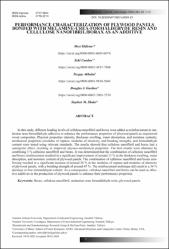Performance Characterization of Plywood Panels Bonded With Melamine-Urea-Formaldehyde Resin and Cellulose Nanofibril/Borax As An Additive
Abstract
In this study, different loading levels of cellulose nanofibril and borax were added as reinforcement in melamine-urea-formaldehyde adhesive to enhance the performance properties of plywood panels as engineered
wood composites. Physical properties (density, thickness swelling, water absorption, and moisture content),
mechanical properties (modulus of rupture, modulus of elasticity, and bonding strength), and formaldehyde
content were tested using relevant standards. The results showed that cellulose nanofibril and borax had a
synergistic effect, resulting in improved physico-mechanical properties. The best results were obtained by
combining 3 % cellulose nanofibril and borax. It was determined that the combination of cellulose nanofibril
and borax reinforcement resulted in a significant improvement of around 15 % in the thickness swelling, water
absorption, and moisture content of plywood panels. The combination of cellulose nanofibril and borax reinforcing resulted in a significant increase of around 26 % in the modulus of rupture and modulus of elasticity
of plywood panels, with a bonding strength of around 47 %. The reinforcement technique did result in a 34 %
decrease in free formaldehyde content. As a consequence, cellulose nanofibril and borax can be used as effective additives in the production of plywood panels to enhance their performance properties.

















